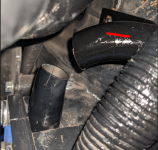OP
Old Time Mountain Farmer
Member
- Joined
- Apr 8, 2022
- Messages
- 33
- Tractor
- Branson 5520
The coupling I used was OK for a temp fix to get the tractor out of its precarious position, but it leaked far too much to be a permanent fix, so the tractor has been dead for the past few weeks as I've worked on other chores.
Unsure how to couple these two pipes together now. Any other suggestions? The angle here is making it hard to get a good fit on a rubber hose as the angle causes the hose opening to turn oblong instead of circular.
I need to get it fixed quick as in a few weeks I will need the tractor to start moving 1 ton feed totes.
The pipe marked in red is the filter-side of the return line.
Unsure how to couple these two pipes together now. Any other suggestions? The angle here is making it hard to get a good fit on a rubber hose as the angle causes the hose opening to turn oblong instead of circular.
I need to get it fixed quick as in a few weeks I will need the tractor to start moving 1 ton feed totes.
The pipe marked in red is the filter-side of the return line.

